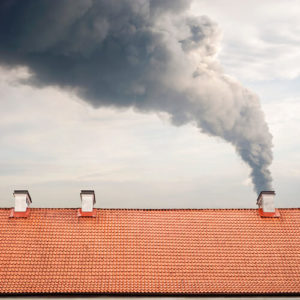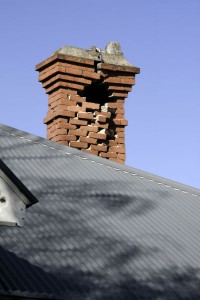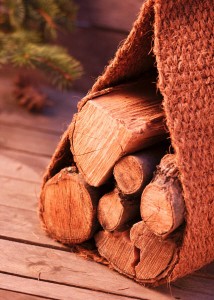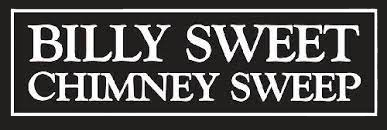by Billy Sweet | Aug 30, 2018 | Creosote, Uncategorized
To say creosote is a minor problem would be an understatement. Creosote is neither rare nor harmless. Every wood-burning fire that you burn in your fireplace and chimney system produces smoke that rises up the chimney. The smoke is filled with hot gases, particles, soot, and creosote that covers the chimney interior. Though soot can be corrosive to the chimney liner and masonry, creosote presents a whole different set of problems.
Creosote Buildup
Soot is made up of carbon, but creosote is made up mostly of tar–a sticky substance that is also flammable. Because of the sticky nature of creosote, it collects easily in a chimney, covering parts, clogging the clean out area, and creating a fire hazard. As the creosote builds up, it can become a serious obstruction–and when it reaches stage 3 buildup it is also difficult to remove.
Stage 3 Creosote
Stage 3 creosote, also called glazed creosote becomes a problem only when the chimney isn’t cleaned regularly. When the creosote isn’t removed on a regular basis, it builds up. When it becomes heated, the creosote boils, causing all the moisture in it to evaporate, and leaves a hardened mass of condensed fuel in the flue. Once it reaches this stage, the creosote can’t be brushed away during a standard chimney sweep. It decreases the chimney’s efficiency, increases the amount of creosote produced by the inefficient fire, and raises the risk of flue fire.
Chimney Damage
Creosote will not damage the chimney when it is cleaned regularly and properly. Once creosote reaches stage 3 buildup it can be difficult to remove without damaging the liner. You cannot remove it with brushes and a homeowner or handyman attempting to do so with tools will cause damage. Additionally, if it isn’t removed, the glazed creosote can cause a creosote fire that damages the masonry, the liner, and even the structure of the chimney. If you suspect a flue fire, you should call a chimney professional for an assessment right away.
Prevent Creosote Buildup
You cannot stop creosote altogether, but you can prevent dangerous buildups.
Schedule Regular Chimney Sweeps – Your chimney sweep appointments will keep your chimney working properly and the chimney professional will assess it with each appointment.
Burn Properly Seasoned Wood – Burning wet or “green” wood that is freshly cut will drop the efficiency of your fireplace. Green wood is harder to light and burns with less heat, often burning incompletely. This leads to more creosote. Burn only properly seasoned firewood in your fireplace to keep your chimney system working properly.
When you do have a creosote buildup in your chimney, it’s important to call the professionals for proper and safe removal. Billy Sweet Chimney Sweep technicians use an industrial product to remove the creosote without damaging the liner and then we clean the entire flue.
Give us a call before you try to remove creosote yourself. It’s harmful to breathe, may irritate your skin, and can destroy your flue if it results in a fire.
Talk to a professional today at 617-469-4528.
by Billy Sweet | Jul 22, 2014 | Chimney Maintenance, chimney sweep, damaged chimney, damaged masonry, spalling, Uncategorized
Did you know your chimney could sweat? Did you know that this process is actually very harmful to your chimney? Well now that it has been brought up, you must learn all the facts. When the bricks of your chimney sweat, spalling can start to occur. If you feel like this could be happening with your chimney, call the professionals at Billy Sweet Chimney Sweep.
What is chimney spalling and how is it caused?

Spalling is what happens when the bricks or stones on your masonry chimney start to come off in flakes or start to go missing because of water penetration. One of the first signs is when you find random bricks on the ground or on your roof. Often times the main cause of spalling is when the water absorbed in the bricks from precipitation freezes and thaws. This can be worsened by the condensation of flue gases in liners that are not the right size, or gaps and cracks in the interior mortar joints. Also, spalling is made more prominent when extra water enters the interior by way of the chimney chase. Softer types of bricks are more likely to have moisture penetration, but are often used over harder types of bricks because they are more cost-friendly.
The chimney will be one of the first places that will show that it has damage since it is constantly exposed to the elements. The spalling will start with the top portions but once one part of the chimney starts to spall the whole inside has already been damaged. These bricks must be replaced since they are permanently damaged.
How can you prevent spalling?
There is no complete way to protect your chimney from water damage, but there are a few things that you can do to help. First, you need to have your chimney waterproofed. Your chimney technician can do that on any dry day after they sweep. The layer of sealant will need about six hours to dry so it is important to plan ahead. If you live somewhere where it rains often, you might look into having a second coat applied. Chimney caps are also another great way to help keep water out, as well as animals and leaves, but must be properly installed to be safe.
by Billy Sweet | Apr 25, 2014 | Uncategorized
Chimney Swifts

These birds are protected by federal law, don’t attempt to remove them yourself.
You may have heard chattering, fluttering, and other noises coming from your chimney and wondered, “Are there birds nesting up there?” Quite possibly, chimney swifts have taken over your chimney as their new home. According to the Driftwood Wildlife Association, chimney swifts are fascinating, adaptable birds who learned to nest and roost in chimneys when their native habitat of large hollow trees in forests of North America were cut down. However, if a family of chimney swifts does nest in your chimney, you should be aware that, according to the Humane Society of the United States, these birds are protected by the Migratory Bird Treaty Act, and removing or destroying nests with eggs or young can result in fines and penalties. Fortunately, the CSIA-certified technicians at Billy Sweet Chimney Sweeps are familiar with the regulations and habits concerning chimney swifts and can work with you on scheduling your annual chimney sweep around the life cycle of the chimney swift as well as fit your chimney with a customized chimney crown to keep the chimney swifts out, if you would rather not share your chimney with these birds.
Protecting These Birds
The Driftwood Wildlife Association formed a special project to promote the conservation of chimney swifts, and they provide valuable information to homeowners through a website, chimneyswifts.org, featuring articles like “Being a Good Chimney Swift Landlord.” With invaluable tips for those who do not mind sharing their chimney with these birds since they do only nest during the summer season, they recommend having your chimney swept in mid-March to have all of the creosote build-up removed, as this makes it impossible for the chimney swifts to build their nests to the walls without danger of falling. The birds make their return from South America after their wintering is over, and as they are migratory, they tend to return to the same nesting area. Like the Humane Society, this article stresses the importance of chimney swifts being protected by federal law and warns against chimney sweep businesses who illegally remove chimney swift nests and eggs. Be wary of companies who advertise “bird removal,” as this is a blatant violation of state and federal laws that protect migratory birds. Instead, choose a company like Billy Sweet Chimney Sweeps, who is active in promoting chimney swift conservation, to perform your annual chimney sweep.
Proper Removal of Their Nests
While the noises of the baby birds chirping for food can be shrill and annoying, they will not last forever. Just keep in mind that this is only temporary, and after that short period, you will rarely know the chimney swifts are there. However, be sure your damper is completely closed to keep them from flying into your house. The nests of these birds are small, cup-shaped constructions of small twigs glued to chimney walls by the birds’ saliva. Too small to be a fire hazard, you will still need to contact Billy Sweet Chimney Sweeps to remove the nest after they leave in the fall. This is needed to remove bird parasites, and since chimney swifts tend to return to the same nest, you do not want them to try to use the old nest as it will be unstable and probably collapse.
If you would like more information about chimney swifts, contact our knowledgeable staff at Billy Sweet Chimney Sweeps. We are happy to answer any questions you may have as well as schedule a chimney sweep for you or a consultation about chimney crown repair.
by Billy Sweet | Nov 18, 2013 | Uncategorized, Wood Stove
Choosing the Right Firewood for Your Fireplace
Are you aware that, just like love that’s right for you, there’s the perfect wood for your fireplace too? Yes, your fireplace also requires attention and care. One way to do so is to burn certain types of wood that suits it and you. By carefully selecting the best wood, it can provide the most efficient fire to warm your cold days as well as ensure the safety of your home. You just have to find out what they are.

You should avoid wood that is wet or too green. Typically, wood needs to be seasoned for at least six months.
Points to Remember
It’s important to know that too much moisture in wood reduces its burning efficiency. The smoke that it produces cannot compensate the heat needed in the home and can cause the build-up of creosote in your chimney since it directly goes there. The harmful chemicals it contains can put your lives in danger too.
We all want the best type of wood especially during the holidays. There are those who prefer more heat and there are those who would rather want lower heat intensity. The wood plays a hand in the intensity of the flame. Another important note to remember, regardless of the type of wood and the characteristics it bestows, is that the wood should be seasoned. The drying process usually takes six to twelve months. Also keep in mind that in order to maintain the natural capability of the wood to produce fire, it has to be properly stored.
Types of Firewood
Trees are either hardwood or softwood. They both produce a limited amount of heat. Both can help you enjoy the rest of the holiday season with the exact warmth you desire. Depending on the kind of fire and the amount of heat you want, you can pick from among these well-seasoned wood.
Softwood can produce a crackling effect on your fire. The pop and crackle sound is something to look out for when the wood starts to burn. It has this vibrant aroma that is just right for the cold winter nights. Pine has all the characteristics a crackling fire needs. Just make sure there are protective screen doors so that no one is harmed when it starts to pop. Softwood can burn quickly, cleanly and more efficiently thus creating a quick burning fire. On the downside, it does not provide too much heat compared to that of hardwood. But there are some who prefer their wood that way. This type of wood can be ignited right away. Cedar and White Spruce are examples of wood used for this kind of fire.
Hardwood, on the other hand, gives off more heat because of its thickness. They have the highest British Thermal Unit content which doubles the output of heat compared to that of softwood. They burn more slowly thus bringing heat to the highest level possible. There is also minimal smoke produced with this type of wood. The only disadvantage of this type of wood is that it takes more time to ignite a fire with it. Some examples are Maple and Oak.
Regardless of the type of wood you prefer, it’s always best to make sure that your fireplace and chimney are intact and safe from any debris or damage. Annual chimney inspection and sweeping is highly recommended. If you are already looking for one, the certified experts of Billy Sweet Chimney Sweep is willing and ready to take care of your fireplace and chimney for you.




